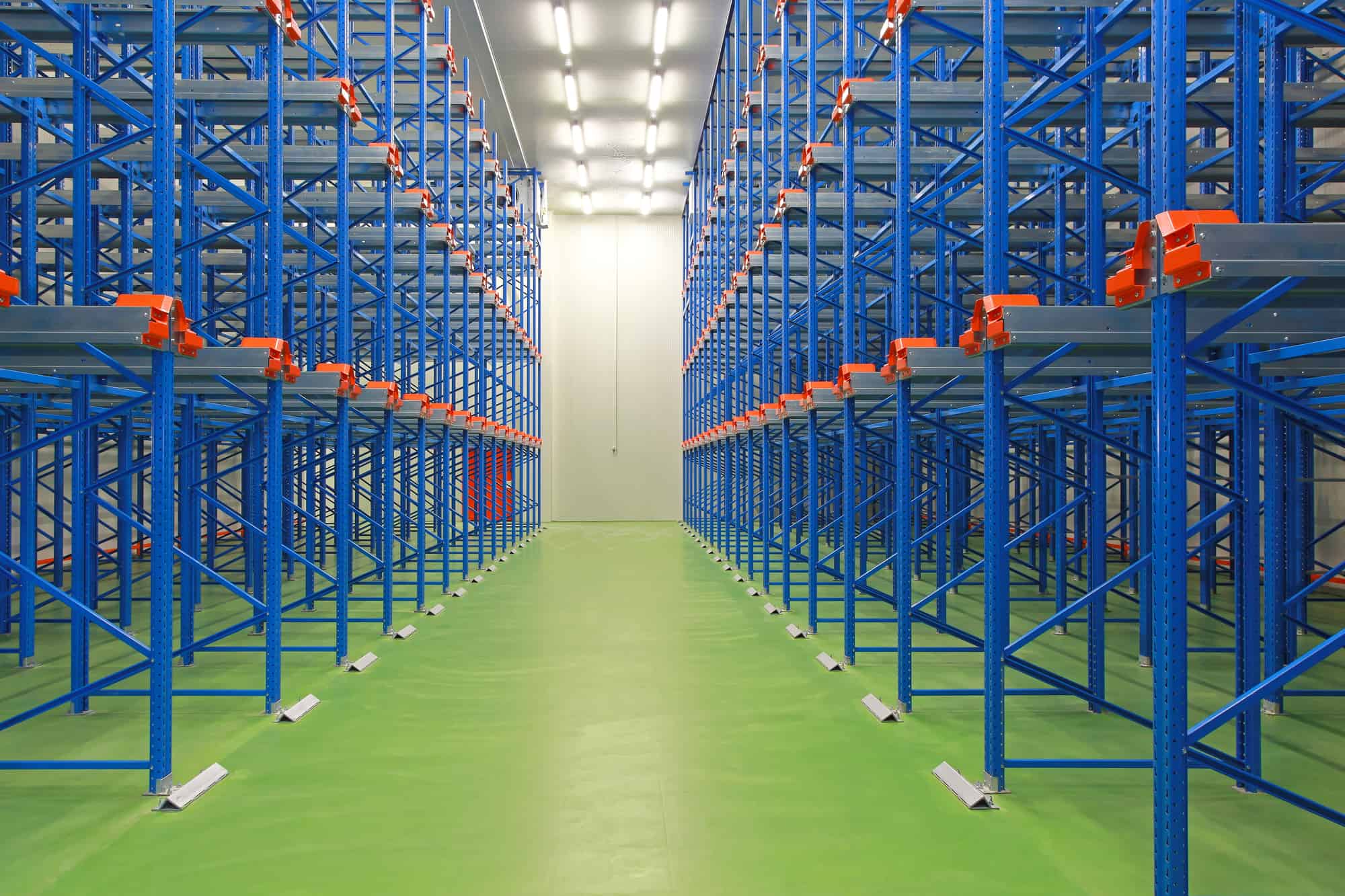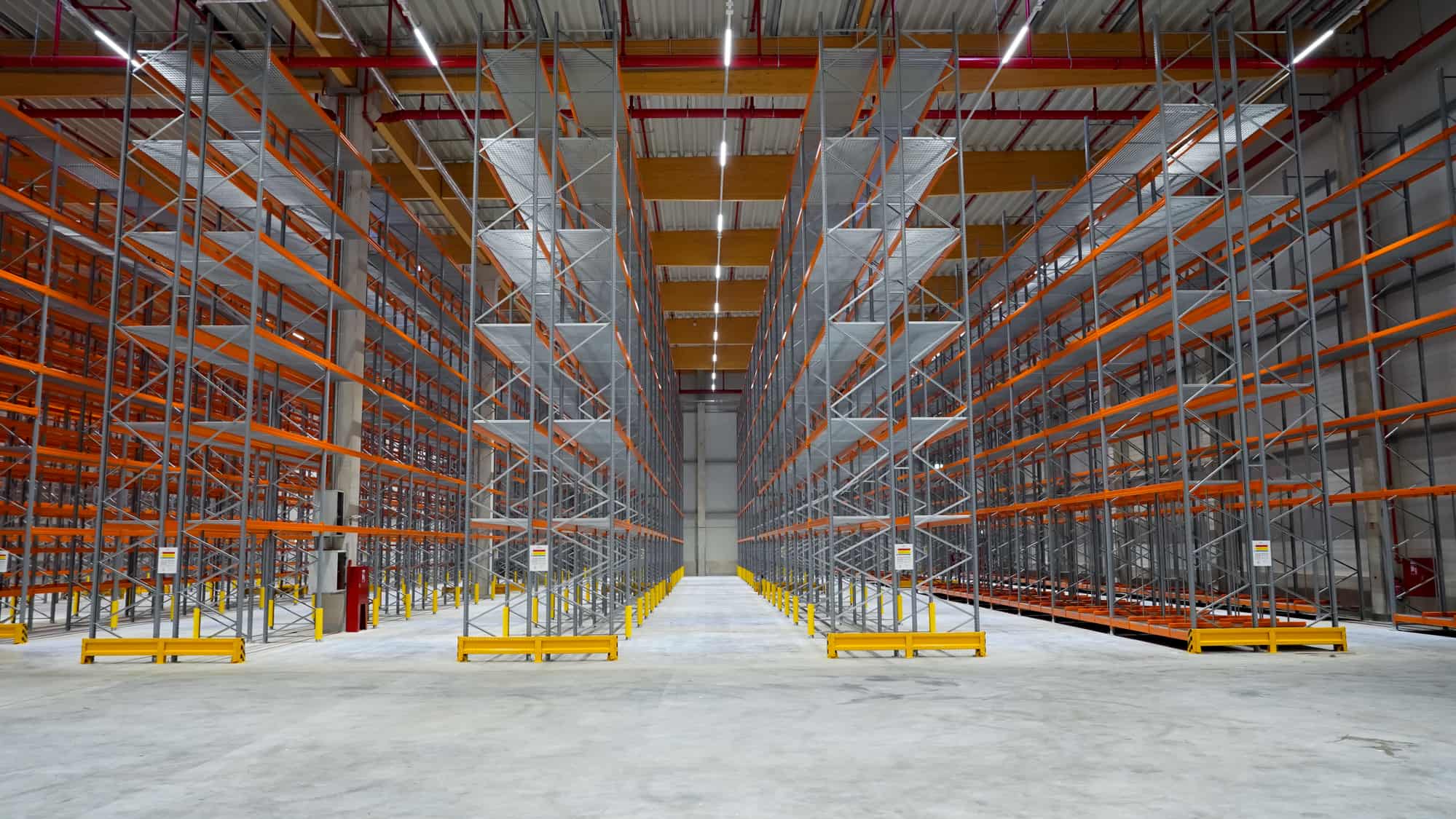With the popularization of computer technology, more and more industries have begun to use computer systems to achieve automation warehousing. Many enterprises have also begun to pursue automatic storage and retrieval equipment in warehouses. However, the cost of fully automatic storage systems is very high, which is not the best choice for small and medium-sized enterprises. While the shuttle racking system is very ideal to meet the needs of many different-sized enterprises.
What Is Shuttle Racking?
The shuttle racking is a semi-automatic racking system, which helps realize the automatic access to the storage products through the pallet shuttle. Shuttle racking is a type of high-density racking. It is designed to use powered shuttles to deliver goods on pallets to the designated locations. Shuttle racking is controlled remotely by the operator, which is super easy and saves a lot of time. Compared with drive-in racking, shuttle racking eliminates the step of driver operating forklift to store or pick the goods at a certain position. By using the shuttle, this can greatly reduce accidents during the movement of the forklift. It also increases the efficiency of the operation. Shuttle racking works well even in freezer chambers with a temperature of minus 30 degrees.
Components of Shuttle Racking
Generally speaking, the main components of shuttle racking includes posts, beams, rails, pallet shuttles and upright protectors. The major difference between shuttle racking system and other racking system is on the semi-automatic shuttle part. The shuttle moves on the rail to bring the goods on the pallet to the designated point in place of the forklift work.
Frame
The frame of the shuttle racking system is composed of posts and bracing. On the floor, there are base plates and floor fixing accessories.
Beam
Besides the uprights, the major parts of the shuttle racking frame are beams. Beams are the horizontal component that connected with the uprights to give support to the whole system.
Shuttle Rails
Shuttle rails are made of metal material, it is where that shuttle can travel on the system. The shuttle rails are supported by the beams.
Pallet Guidance
Pallet guidance is situated at the start and end of each level, on each side of the lane, to facilitate the task of depositing the unit loads and prevent them from veering from their correct course.
Rail Backstop
Component located at the end of the lane, in the unloading area whose purpose is to inform the shuttle of the end of the rail and activate its braking and stopping system.
Pallet Shuttle
Pallet shuttle is the key part of the shuttle racking system. It is consisted of a base platform and several wheels. The shuttle is equipped with different sensors to implement safety operation.
Pallet Shuttle Remote Control
The remote control is the tool for warehouse employee to control the pallet shuttle. It is very simple to use and sensitive. You can check the information on the remote control screen for shuttle’s battery level or other information like maintenance advice. Mostly, a remote control can control up to 4 pallet shuttles.
How does Shuttle Racking System Work?
Shuttle racking system can be set to work either under a FIFO configuration or a LIFO configuration. The shuttle racking system is operated by using remote control, radio signal or WiFi. The only thing the forklift driver needs to do is to simply place the pallet with goods on the shuttle, then the shuttle would automatically transport them all along the rail to the next available space on the racking. After the shuttle has placed the pallet in the designated position, it can return to the entrance and continue for the next operation. The advantage of shuttle racking is that it greatly saves the time of human labor operation. Radio shuttle racking system is suitable for large warehouse storage, especially large freezer chambers. Shuttle racking system configuration is decided by the factors such as warehouse area, type of goods stored, pallet size, etc. The number of shuttles depends on a combination of factors such as the depth of the aisle, the total amount of pallets, and the frequency of shipments. Compared with other types of racking systems, the radio shuttle racking system has greater advantages in warehouse space utilization, goods storage efficiency and racking investment cost.
Three Main Features of Shuttle Racking System
1. Organized and Diversified Product Categories
Since the shuttle racking system is designed into organized aisles, which means your goods can be stored very organized and easy to access. What’s more, to store goods under different category for each aisle is also possible.
2. High Efficiency
If you have seriously compared the time cost between using driving-in racking system and shuttle racking system, you would be amazed to find that the time used to store on shuttle racking system is so much less than drive-in racking. Time is money. You are saving money through a shuttle racking system.
3. Saving Labor Cost
By using shuttle racking system, you have your warehouse employee number cut down. The same person can handle more work after the shuttle racking system configured in the warehouse.
Five Advantages of Using Shuttle Racking System
1. Saving Space
Compared with the general pallet racking system, shuttle racking system greatly saves the warehouse space and makes full use of the warehouse space because the whole racking system has no aisles between lanes of racking.
2. Saving Time
Compared to any other racking system, the radio shuttle racking system requires the least loading and unloading time. It is very convenient and fast to transport the goods on the pallet from one end of the warehouse to the other end just by pressing the button on the remote control.
3. Saving Money
Shuttle racking system can help you save labor cost, that is, employees’ wages. This makes sense in most of companies where wage is a big part in the total cost. Therefore, if shuttle racking can help you replace human operation with machines, it is indeed equivalent to saving you money.
4. Increasing Productivity
If your warehouse is adopted with other racking system, then even if you are equipped with enough warehouse personnel, it is still difficult for you to have a significant improvement in work productivity. Manual work has limitations. If you use shuttle racking, this semi-automatic operating system can instantly help you increase work productivity by completing the process of moving the goods from entry to the designated storage location in a timely manner.
5. Reducing Accidents and Increasing Safety
Forklift does not need to drive into the driveway, so the risk of an accident is virtually non-existent. Machines are more accurate than humans. Wrong operations or accidents may happen due to labor’s fatigue or desertion, while machines will only follow the program that the system has already set. So by using shuttle racking system, you can have your warehouse accidents reduced to the minimum.
Some Limitations of Radio Shuttle Racking System
Flatness of the Ground
In order to ensure the normal operation of the shuttle racking system, there are high requirements for the accuracy of rail and evenness of floor. If the ground is uneven, the installed shuttle may not work properly on the system.
Higher Maintenance Cost than Regular Pallet Racking
Some parts of the maintenance cost of the shuttle racking system would be higher than the general racking system. Because maintenance of shuttle racking requires professional product knowledge, this may not be a job that an in-house engineer can do. Therefore, additional professional team maintenance service fees are required.
Longer Time for Repair
If the radio pallet shuttle fails, it may take longer time to repair. This is because it is a product that requires professional engineer to repair at site or even need to send it to the factory for repair. Generally, most customers will prepare an extra battery at site for backup.
Main Applications of Radio Shuttle Racking System
- Chemical industry
- Food industry
- Electrical industry
- Pharmaceutical industry
- Freezing chambers
- Logistics distribution centers
Two Things to Note When Using Shuttle Racking System
Regular Maintenance
Regular maintenance of shuttle and shuttle racking system is required. The shuttle works with a charging system. It should be charged in time when the power is insufficient during use. You can’t wait until the power is completely used up. That will not only shorten the life of the shuttle, but also bring unnecessary trouble to accessing goods. The shuttle must be operated in accordance with the maintenance instructions during the maintenance process. The shuttle racking also needs to be inspected regularly, at least to ensure that there is a serious inspection and maintenance every year.
Cannot be Overloaded
Shuttle racking cannot be overloaded. Overloading is a big taboo for all racking systems. The biggest consequence of overloading is to cause partial deformation of the racks and bring security risks.
Differences Between Shuttle Racking System and Drive-in Racking System
Shuttle racking system and drive-in racking system are the most common racking systems used in the modern warehousing industry. Shuttle racking system has the characteristics of high storage density, high efficiency in access and storage, and have better management capabilities for goods than traditional drive-in racking system. Drive-in racking is suitable for the storage of goods with few varieties and large batches. Drive-in racking system requires the forklift to enter into the racking to load and unload the goods. Both two systems have important applications in modern logistics and warehousing, so what is the difference between these two systems?
Different Stability
For drive-in racking system, given the fact that forklifts are required to enter into the inside of the system lane to work, there is possibility that the forklift could touch the racks during driving. Due to the intensive storage of goods, there are not many extra components inside the system to offer support to the rack itself, and the higher the number of levels, the greater the pressure on the racking itself. Therefore, for the sake of stability, the drive-in racking system should not be constructed too high. While in comparison, the shuttle racking does not require the forklift to enter into the system, so horizontal beams could be installed to connect all the uprights together, which greatly increases the stability of the whole system.
Different Storage Methods
In the operation of the shuttle racking system, the forklift only needs to put the goods on the waiting shuttle. Then the goods will be moved by the shuttle to realize the storage work. The drive-in racking is different. It requires driver manually drive a forklift into the interior of the rack aisle to access the goods.
Different Storage Turnover Rate
Drive-in racking system provides better turnover rate than many other traditional racking system. However, operations related to drive-in racking are mainly manual operations. Compared to the shuttle racking, mainly automated operation, the latter is more efficient on the products turnover rate.
Different Return-On Investment
The return on investment of shuttle racking is higher than that of drive-in racking. In the early stage of investment, shuttle racking requires more capital investment than drive-in racking. But in the later operation, the automatic equipment is much more efficient than the manual one. If you prefer long-term ROI, you can choose shuttle racking system.
Q&A About Shuttle Racking System
What is the detailed instruction to use shuttle racking system?
Firstly, a forklift places the Pallet Shuttle into the channel where work is to be done.
Next, the forklift is used to position pallets one by one in the channel entrance, resting them on the load-bearing beams.
Using the tablet or remote control, the operator sends a command to the shuttle to start the loading operation. Once the pallet’s location has been identified, the radio shuttle lifts the pallet slightly upward. It then moves horizontally until it reaches the first available location.
After that, the pallet shuttle returns to the front of the lane to repeat the operation with the next pallet, and so on, until the channel is full.
How do I charge the shuttle?
By using charging station, you can re-charge the batteries by placing both battery cassettes into the pull-out drawer, which automatically connects the batteries to power.
If there’s obstacle on the rail, will the shuttle be stopped?
Yes. The radio pallet shuttle is outfitted with numerous sensors to detect pallets and obstacles. When sensors detect an obstruction in the path, the shuttle will come to a stop and sound an alarm to notify users of an issue.
What should I do if the pallet shuttle fails to work?
The pallet shuttle has the following safety designs to avoid failures.
1. Anti object collision design;
2. Anti-collision design for multi-vehicle operation;
3. Laser positioning protection system, there is no need for anti-collision signs on the track;
4. Designed to reduce vicious work failures;
5. Equipped with the battery power shortage alarm – when the battery is not enough to run once, the shuttle car would stop at the entrance and wait for processing.
If you really don’t know how to fix the problem you encountered, you are suggested to consult the professional shuttle racking system team or your original supplier.
What is the lowest ambient temperature that the shuttle racking system can accommodate?
The shuttle racking system can function normally in the freezer chambers and can withstand the temperature of minus 30 degrees.







